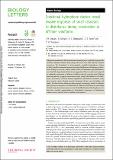Files in this item
Directional hydrophone clusters reveal evasive responses of small cetaceans to disturbance during construction at offshore windfarms
Item metadata
| dc.contributor.author | Graham, I. M. | |
| dc.contributor.author | Gillespie, D. | |
| dc.contributor.author | Gkikopoulou, K. C. | |
| dc.contributor.author | Hastie, G. D. | |
| dc.contributor.author | Thompson, P. M. | |
| dc.date.accessioned | 2023-01-20T17:30:10Z | |
| dc.date.available | 2023-01-20T17:30:10Z | |
| dc.date.issued | 2023-01-18 | |
| dc.identifier | 283034948 | |
| dc.identifier | f3014239-da34-4f26-a2e2-228e63f42dc2 | |
| dc.identifier | 85146411488 | |
| dc.identifier | 000914769400002 | |
| dc.identifier.citation | Graham , I M , Gillespie , D , Gkikopoulou , K C , Hastie , G D & Thompson , P M 2023 , ' Directional hydrophone clusters reveal evasive responses of small cetaceans to disturbance during construction at offshore windfarms ' , Biology Letters , vol. 19 , no. 1 , 20220101 . https://doi.org/10.1098/rsbl.2022.0101 | en |
| dc.identifier.issn | 1744-9561 | |
| dc.identifier.other | Jisc: 845535 | |
| dc.identifier.other | publisher-id: rsbl20220101 | |
| dc.identifier.other | ORCID: /0000-0002-9773-2755/work/127065761 | |
| dc.identifier.other | ORCID: /0000-0001-9628-157X/work/127066287 | |
| dc.identifier.other | ORCID: /0000-0002-9232-4138/work/127066351 | |
| dc.identifier.uri | https://hdl.handle.net/10023/26806 | |
| dc.description | Funding: This study was funded by Moray Offshore Wind Farm (East) Ltd. | en |
| dc.description.abstract | Mitigation measures to disperse marine mammals prior to pile-driving include acoustic deterrent devices and piling soft starts, but their efficacy remains uncertain. We developed a self-contained portable hydrophone cluster to detect small cetacean movements from the distributions of bearings to detections. Using an array of clusters within 10 km of foundation pile installations, we tested the hypothesis that harbour porpoises (Phocoena phocoena) respond to mitigation measures at offshore windfarm sites by moving away. During baseline periods, porpoise movements were evenly distributed in all directions. By contrast, animals showed significant directional movement away from sound sources during acoustic deterrent device use and piling soft starts. We demonstrate that porpoises respond to measures aimed to mitigate the most severe impacts of construction at offshore windfarms by swimming directly away from these sound sources. Portable directional hydrophone clusters now provide opportunities to characterize responses to disturbance sources across a broad suite of habitats and contexts. | |
| dc.format.extent | 6 | |
| dc.format.extent | 760722 | |
| dc.language.iso | eng | |
| dc.relation.ispartof | Biology Letters | en |
| dc.subject | Evasive response | en |
| dc.subject | Mitigation measures | en |
| dc.subject | Acoustic deterrent device | en |
| dc.subject | Offshore windfarm | en |
| dc.subject | Passive acoustic monitoring | en |
| dc.subject | Phonotaxis | en |
| dc.subject | QH301 Biology | en |
| dc.subject | QL Zoology | en |
| dc.subject | DAS | en |
| dc.subject | SDG 14 - Life Below Water | en |
| dc.subject | MCC | en |
| dc.subject.lcc | QH301 | en |
| dc.subject.lcc | QL | en |
| dc.title | Directional hydrophone clusters reveal evasive responses of small cetaceans to disturbance during construction at offshore windfarms | en |
| dc.type | Journal article | en |
| dc.contributor.institution | University of St Andrews. Arctic Research Centre | en |
| dc.contributor.institution | University of St Andrews. School of Biology | en |
| dc.contributor.institution | University of St Andrews. Sea Mammal Research Unit | en |
| dc.contributor.institution | University of St Andrews. Scottish Oceans Institute | en |
| dc.contributor.institution | University of St Andrews. Sound Tags Group | en |
| dc.contributor.institution | University of St Andrews. Bioacoustics group | en |
| dc.contributor.institution | University of St Andrews. Marine Alliance for Science & Technology Scotland | en |
| dc.contributor.institution | University of St Andrews. Centre for Energy Ethics | en |
| dc.identifier.doi | 10.1098/rsbl.2022.0101 | |
| dc.description.status | Peer reviewed | en |
This item appears in the following Collection(s)
Items in the St Andrews Research Repository are protected by copyright, with all rights reserved, unless otherwise indicated.

